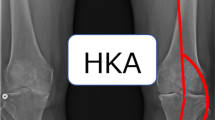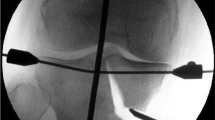Abstract
Purpose
To compare the radiographic, clinical, and arthroscopic outcomes of varus osteoarthritic knees treated with an open-wedge high tibial osteotomy (OWHTO) alone or with a double-level osteotomy (DLO). It was hypothesized that treatment with DLO would maintain the joint line obliquity (JLO) and acquire better arthroscopic and clinical outcomes after surgery than OWHTO alone.
Methods
Knees with predicted medial proximal tibial angle (MPTA) > 95° were treated with OWHTO alone or with DLO. Preoperatively, age, body mass index, and hip-knee-ankle angle (HKA) differed between the two groups. Therefore, after adjustment for those factors, 34 knees with OWHTO alone and 34 knees with DLO were compared. On whole-leg radiographs for a single leg, HKA, weightbearing line (WBL) ratio, lateral distal femoral angle (LDFA), MPTA, and JLO were measured before and 2 years after surgery. Clinical outcomes were evaluated by the Knee Society Score (KSS) knee, KSS function, Lysholm, and Knee injury and Osteoarthritis Outcome Score (KOOS) scores before and 2 years after surgery. Arthroscopic findings were obtained before and 1 year after surgery. Various factors were compared between the two groups.
Results
JLO increased significantly from 1.4° to 6.3° in the OWHTO group (p < 0.001) and changed from 1.0° to 1.3° in the DLO group (n.s.). Postoperative MPTA and JLO in the OWHTO group were significantly higher than those in the DLO group (both p < 0.001). There were no significant differences in the KSS knee, KSS function, and KOOS scores between the two groups. Postoperative Lysholm score in the DLO group was higher than that in the OWHTO group (p < 0.025). Femoral and tibial cartilage regeneration in the medial condyles and deterioration in the lateral condyles did not differ between the two groups on second-look arthroscopy.
Conclusions
JLO was not significantly changed after surgery in the DLO group. DLO enabled the acquisition of physiological JLO compared with OWHTO alone.
Level of evidence
Retrospective comparative study, Level III.



Similar content being viewed by others
Availability of data and material
The datasets generated during and/or analyzed during the current study are available from the corresponding author on reasonable request.
References
Akamatsu Y, Mitsugi N, Mochida Y, Taki N, Kobayashi H, Takeuchi R, Saito T (2012) Navigated opening wedge high tibial osteotomy improves intraoperative correction angle compared with conventional method. Knee Surg Sports Traumatol Arthrosc 20:586–593
Akamatsu Y, Kumagai K, Kobayashi H, Tsuji M, Saito T (2018) Effect of increased coronal inclination of the tibial plateau after opening wedge high tibial osteotomy. Arthroscopy 34:2158–2169
Babis GC, An KN, Chao EY, Rand JA, Sim FH (2002) Double level osteotomy of the knee: a method to retain joint-line obliquity. Clinical results. J Bone Jt Surg Am 84:1380–1388
Benjamin A (1969) Double osteotomy for the painful knee in rheumatoid arthritis and osteoarthritis. J Bone Jt Surg Br 51:694–699
Brinkman JM, Hurschler C, Agneskirchner JD, Freiling D, van Heerwaarden RJ (2011) Axial and torsional stability of supracondylar femur osteotomies: biomechanical comparison of the stability of five different plate and osteotomy configurations. Knee Surg Sports Traumatol Arthrosc 19:579–587
Brittberg M, Peterson L, Sjögren-Jansson E, Tallheden T, Lindahl A (2003) Articular cartilage engineering with autologous chondrocyte transplantation. A review of recent developments. J Bone Jt Surg Am 85(suppl 3):109–115
Faul F, Erdfelder E, Buchner A, Lang AG (2009) Statistical power analyses using G*Power 3.1: tests for correlation and regression analyses. Behav Res Methods 41:1149–1160
Fujisawa Y, Masuhara K, Shiomi S (1979) The effect of high tibial osteotomy on osteoarthritis of the knee. An arthroscopic study of 54 knee joints. Orthop Clin North Am 10:585–608
Goshima K, Sawaguchi T, Shigemoto K, Iwai S, Nakanishi A, Inoue D, Shima Y (2019) Large opening gaps, unstable hinge fractures, and osteotomy line below the safe zone cause delayed bone healing after open-wedge high tibial osteotomy. Knee Surg Sports Traumatol Arthrosc 27:1291–1298
Insall JN, Dorr LD, Scott RD, Scott WN (1989) Rationale of the Knee Society clinical rating system. Clin Orthop Relat Res 248:13–14
Jung WH, Takeuchi R, Chun CW, Lee JS, Ha JH, Kim JH et al (2014) Second-look arthroscopic assessment of cartilage regeneration after medial opening-wedge high tibial osteotomy. Arthroscopy 30:72–79
Kellgren JH, Lawrence JS (1957) Radiological assessment of osteo-arthrosis. Ann Rheum Dis 16:494–502
Koshino T, Yoshida T, Ara Y, Saito I, Saito T (2004) Fifteen to 28 years’ follow-up results of high tibial valgus osteotomy for osteoarthritic knee. Knee 11:439–444
Krackow KA (1983) Approaches to planning lower extremity alignment for total knee arthroplasty and osteotomy about the knee. Adv Orthop Surg 7:69–88
Lobenhoffer P, Agneskirchner JD (2003) Improvements in surgical technique of valgus high tibial osteotomy. Knee Surg Sports Traumatol Arthrosc 11:132–138
Nakamura R, Komatsu N, Murao T, Okamoto Y, Nakamura S, Fujita K et al (2015) The validity of the classification for lateral hinge fractures in open wedge high tibial osteotomy. Bone Jt J 97-B:1226–1231
Nakayama H, Schröter S, Yamamoto C, Iseki T, Kanto R, Kurosaka K, Kambara S, Yoshiya S, Higa M (2018) Large correction in opening wedge high tibial osteotomy with resultant joint-line obliquity induces excessive shear stress on the articular cartilage. Knee Surg Sports Traumatol Arthrosc 26:1873–1878
Nakayama H, Iseki T, Kanto R, Kambara S, Kanto M, Yoshiya S, Schröter S (2020) Physiologic knee joint alignment and orientation can be restored by the minimally invasive double level osteotomy for osteoarthritic knees with severe varus deformity. Knee Surg Sports Traumatol Arthrosc 28:742–750
Roos EM, Roos HP, Lohmander LS, Ekdahl C, Beynnon BD (1998) Knee Injury and Osteoarthritis Outcome Score (KOOS): development of a self-administered outcome measure. J Orthop Sports Phys Ther 28:88–96
Saragaglia D, Mercier N, Colle PE (2010) Computer-assisted osteotomies for genu varum deformity: which osteotomy for which varus? Int Orthop 34:185–190
Schröter S, Elson DW, Ateschrang A, Ihle C, Stöckle U, Dickschas J, Harrer J (2017) Lower limb deformity analysis and the planning of an osteotomy. J Knee Surg 30:393–408
Schröter S, Nakayama H, Yoshiya S, Stöckle U, Ateschrang A, Gruhn J (2019) Development of the double level osteotomy in severe varus osteoarthritis showed good outcome by preventing oblique joint line. Arch Orthop Trauma Surg 139:519–527
Staubli AE, De Simoni C, Babst R, Lobenhoffer P (2003) TomoFix: a new LCP-concept for open wedge osteotomy of the medial proximal tibia—early results in 92 cases. Injury 34(Suppl 2):B55-62
Takeuchi R, Ishikawa H, Aratake M, Bito H, Saito I, Kumagai K, Akamatsu Y, Saito T (2009) Medial opening wedge high tibial osteotomy with early full weight bearing. Arthroscopy 25:46–53
Tegner Y, Lysholm J (1985) Rating systems in the evaluation of knee ligament injuries. Clin Orthop Relat Res 198:43–49
Acknowledgements
The authors thank Alison Sherwin, PhD, from Edanz Group for editing a draft of this manuscript. The authors deeply appreciate the surgical instructions of Prof. Steffen Schröter in the BG Trauma Center Tübingen for 6 months.
Funding
No funding was obtained for this study.
Author information
Authors and Affiliations
Contributions
YA study design, data collection, interpretation of the data, and writing of the paper. SN data collection. MT, HK, and SM interpretation of the data.
Corresponding author
Ethics declarations
Conflict of interest
The authors report no conflicts of interest.
Ethics approval
Ethical approval for the study was obtained from the Institutional Review Board of Yokohama City University Hospital (B120906024).
Consent to participate
Written informed consent was obtained from all the participants.
Consent for publication
Written informed consent was obtained from all the participants.
Additional information
Publisher's Note
Springer Nature remains neutral with regard to jurisdictional claims in published maps and institutional affiliations.
Rights and permissions
About this article
Cite this article
Akamatsu, Y., Nejima, S., Tsuji, M. et al. Joint line obliquity was maintained after double-level osteotomy, but was increased after open-wedge high tibial osteotomy. Knee Surg Sports Traumatol Arthrosc 30, 688–697 (2022). https://doi.org/10.1007/s00167-020-06430-6
Received:
Accepted:
Published:
Issue Date:
DOI: https://doi.org/10.1007/s00167-020-06430-6




